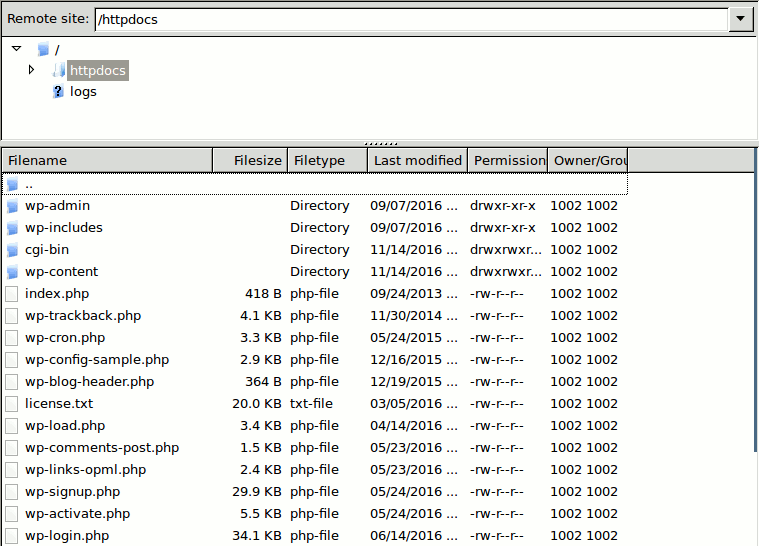Difference between revisions of "Cloud Hosting/Upload Content"
| Line 30: | Line 30: | ||
[[File:Ftp2.png]] | [[File:Ftp2.png]] | ||
| − | + | -------------- | |
[[Category:Troubleshooting]] | [[Category:Troubleshooting]] | ||
[[Category:Hosting Troubleshooting]] | [[Category:Hosting Troubleshooting]] | ||
[[Category:Getting Started]] | [[Category:Getting Started]] | ||
{{:Cloud Hosting}} | {{:Cloud Hosting}} | ||
Revision as of 15:19, 16 November 2016
Contents
- 1 What is FTP?
- 1.1 How does FTP work with my Cloud Server Hosting?
- 1.2 How do I connect to my Cloud Hosting FTP server via an FTP Client?
- 1.3 Cloud Hosting - Getting Started
- 1.4 Secure your Website
- 1.5 Protect your Website
- 1.6 FTP Access
- 1.7 SSH Access
- 1.8 Server Logs
- 1.9 Scheduled Tasks
- 1.10 Migrating MySql
- 1.11 Cloud PHP Info
- 1.12 Host Files
- 1.13 SSH Keys
- 1.14 Server Security
What is FTP?
FTP (File Transfer Protocol) is a protocol used to transfer files over a TCP/IP network (Internet, UNIX, etc.). For example, after developing the HTML pages for a website on a local machine, they are typically uploaded to the Web server using FTP.
We highly recommend using an FTP client, such as Filezilla which is available at https://ninite.com/filezilla/.
As there are many FTP clients out there, the interface for each will differ slightly. The screenshots used in the instructions below are from Filezilla but the basic settings should be the same no matter what FTP client you choose.
How does FTP work with my Cloud Server Hosting?
FTP is the recommended way to upload the files you have created for your website to your server. In general, FTP, both as a command-line function and as utility, is more reliable than uploading files via your web browser.
How do I connect to my Cloud Hosting FTP server via an FTP Client?
As mentioned, every FTP client has a slightly different interface. However, the three pieces below are typically all that is necessary to create an FTP connection:
- Host Address = The URL for your site appended with 'ftp' in the beginning. Example: ftp.yourdomain.com
NOTE: If your nameservers are not pointing to XMission, please use your Cloud Servers IP address.
- UserID or Username = username (Your FTP username. For more information on creating and managing FTP users, please see FTP Access and Accounts)
- Password = password (Your FTP password. For more information on creating and managing FTP user passwords, please see FTP Access and Accounts)
- Port = Port # (The default for most FTP client is 21. If you want to use a secure connection use 22.)
NOTE: If your nameservers are not pointing to XMission, please use the IP address for your Cloud Server for your host name. This can be found in your VPS Manager tab.
- Once the connection is complete, you will both the local site (your computer or device) and the remote site (the web server):
- In most cases, the root folder for your website is going to httpdocs and you will want to upload the files for your website to this directory. This can be done a variety of ways. You can select the files you want to upload, and right click them for uploading options, or you can also simply drag them to the remote site and folder you would like them to be uploaded to.
Cloud Hosting - Getting Started
To manage your Cloud Server, you will access the XMission Cloud Hosting Control Panel
For assistance in navigating your XMission Control Panel, please visit
Secure your Website
What is a SSL Certificate and How does it work?
Please vist to review a quick overview on why securing your website is a good idea.
Protect your Website
If you would like to learn how to control access to your server Click Here
- XMission does recommend consulting a PHP or Apache Developer to ensure your .htaccess file is configured correctly. This could block total access to your Cloud Server.
FTP Access
FTP Access is typically recommend to connect to your Cloud Server. XMission requires SFTP Access to all hosting servers and suggests using FileZilla. To get help with acessing your server via FTP Click Here
SSH Access
From time to time you may need or want to use the command line to log in to your server. Your Cloud Server is accessible via a Secure Shell Interface also referred to as SSH. For help accessing your server via SSH please Click Here
Server Logs
You may need to look at your server logs. These can be access via SSH or FTP. To locate those logs Click Here
Scheduled Tasks
Cron enables users to schedule jobs (commands or shell scripts) to run automatically at a certain time or date. Some best practices to setting up Cron's:
Migrating MySql
If you are moving an excising website to your XMission Cloud Server, a MySql Database is most likely needed. If you'd need some help importing that database please Click Here
Cloud PHP Info
XMission's Default PHP Info for your Cloud Server: PHP Info
Host Files
How to set up Host Files
SSH Keys
SSH keys allow users to SSH to servers with a more secure method rather than having to rely on passwords alone. To set up SSH Keys Click Here
Server Security
For customers that sign up for Unmanaged Cloud Servers, XMission strongly recommends a few easy steps to take to ensure that your unmanaged Cloud Server stays up-to-date and secure at all times.

